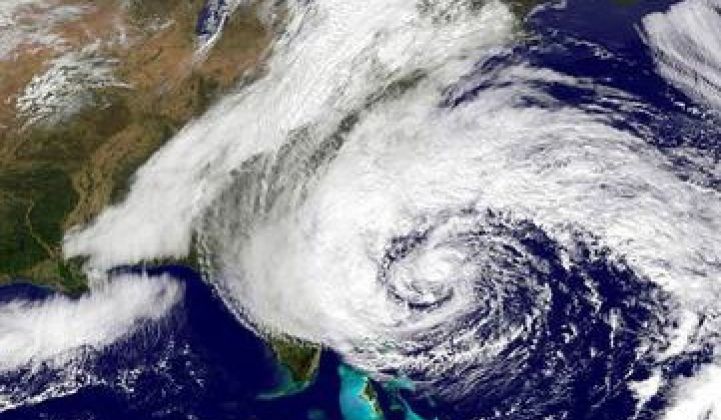Fresh on the heels of Hurricane Sandy’s destruction last year, East Coast utilities are girding their grids for future storms, including a 2013 hurricane season that’s shaping up to be a tough one, according to the latest forecasts. That spending includes billions of dollars for concrete, steel and other hard asset repairs and retrofits, like waterproofing substations. But it also includes some longer-range goals that fit into the region’s ongoing smart grid projects, as well as its long-term smart grid imperatives.
Take New York utility Consolidated Edison, which announced last week that it is putting $2.2 billion into a multi-year set of grid strengthening projects in preparation for future storms, to cost individual customers about $3 per month in additional rates.
That includes $1 billion on fortifying transfer stations, power lines and other grid assets over the next four years, of which some $475 million is going to its electric distribution system to “help limit damage from major storms, and reduce the number and duration of customer outages,” according to the company’s statement.
Lots of that investment is focused at the low-lying, flood-prone substations and underground grid assets in New York City, where last year’s Hurricane Sandy storm surge caused major grid disruptions and some spectacular explosions caught on camera. We’ve covered some of the work being done to waterproof substations, automate fault location, isolation and restoration, and improve the capacity and connectivity of underground utility distribution lines and other grid assets.
But ConEd is also spending money quickly to get ready for what’s expected to be another record-setting peak demand summer. Part of the utility’s newly announced plans includes $1.2 billion to be spent this year on grid capacity improvements to match a projected peak demand of 13,200 megawatts this summer, beating last year’s record 13,189 megawatts.
A lot of that spending is on the bulk hardware that goes into electricity distribution, including the “installation of 31 network transformers, six new feeders, 207 overhead transformers, and reinforcement of 46 feeders, 100 underground sections and 250 overhead spans,” as well as two unit substation upgrades.
But there’s only so much ConEd can do to increase the capacity of its jam-packed metropolitan underground grid, making on-site (i.e., customer-side) energy storage, distributed generation and demand response attractive components of an overall summer peak mitigation strategy -- and the utility is pursuing all those options, along with the IT systems to monitor and manage it all. ConEd also has $181 million in Department of Energy stimulus grants and plans for smart meters, distribution grid automation and integration of buildings, renewable energy and plug-in vehicles that could tie into the summer peak management solution.
Elsewhere in New York state, the beleaguered Long Island Power Authority, which saw 82 percent of its customers left without power during Sandy, is in the midst of being taken over by Public Service Enterprise Group (NYSE: PEG), which owns New Jersey’s Public Service Electric & Gas. PSE&G has already released its own $4 billion “Energy Strong” plan to protect critical facilities and deploy smart grid across the distribution network.
In neighboring Pennsylvania, PECO announced last week that it has completed some 50 projects to prepare for the summer peak, including powerline, substation and facilities maintenance; equipment replacement and upgrades; and “maintenance and testing of various computer and support systems.” PECO, as with many other mid-Atlantic utilities, lies within the territory of grid operator PJM, where demand response -- turning down power use at big industrial and commercial users to mitigate peak loads -- is an increasingly important part of the summer power management mix.
Baltimore Gas & Electric also announced some pre-summer preparation last week, with a focus on getting its customers involved via its PeakRewards tariff program. BG&E has already talked about how its ongoing deployment of smart meters has helped it reduce truck rolls and phone calls by letting grid operators know which homes do or don’t have power during an outage or storm.
Utilities face plenty of regulatory imperatives to make these investments. Andrew Cuomo, the governor of New York, has opened an investigation into the state’s utilities’ response to Hurricane Sandy, which led to the reprivatization of LIPA. Past storms haven't escaped scrutiny either. Massachusetts state regulators last year imposed $24.8 million in fines for utilities National Grid, NSTAR and Western Massachusetts Electric Co. for "systematic failures" in response to 2011 snowstorms that knocked out power statewide, and Maryland state legislators have urged regulators to fine Baltimore Gas & Electric and Pepco after 2012 storms that left some customers without power for as long as a week.
The National Oceanic and Atmospheric Administration (NOAA) predicts that there is a 70 percent likelihood of twelve to eighteen “named” storms this 2013 hurricane season (June 1-Nov. 30), of which six to ten could become hurricanes, and of which three to six could become major hurricanes like Sandy. Translating data like that into hard dollar figures on how much grid investment is required to prepare for it is a complex task indeed. But with increasingly unpredictable weather, utilities and their big IT partners are also putting an increased focus on big data integration and analysis to help make sense of it all.



